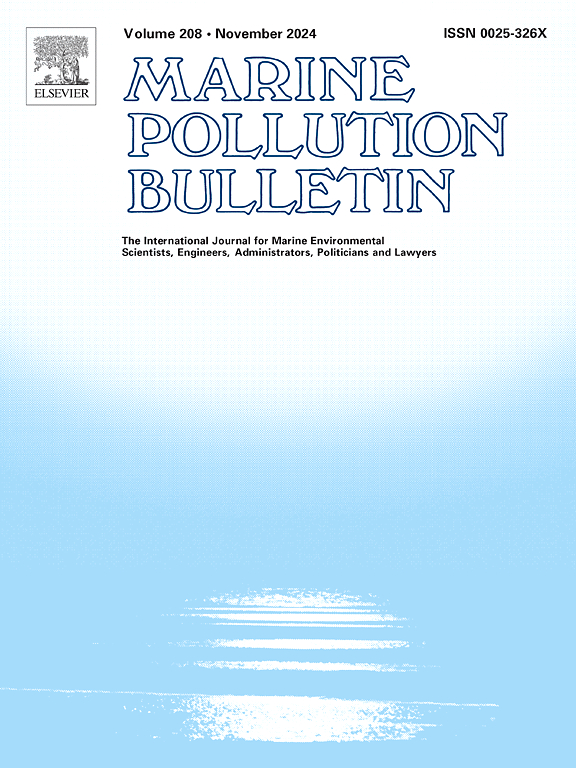人为富钙限磷对球形褐囊藻华形成的影响
IF 5.3
3区 环境科学与生态学
Q1 ENVIRONMENTAL SCIENCES
引用次数: 0
摘要
球形Phaeocystis globosa是一种形成开花的褐生植物,在磷限制(p限制)的沿海环境中占主导地位,由于人为输入,钙浓度也日益升高。然而,磷限制和钙富集在形成藻华动力学中的相互作用仍然知之甚少。本文研究了在p -富(36.20 μmol/L)和p -限(13.75 μmol/L)条件下,不同钙浓度([Ca2+])(400、800和1500 mg/L)下,球藻的生理和转录组反应。结果表明,球藻对[Ca2+]升高的响应强烈依赖于磷的有效性。在磷限制下,400-800 mg/L [Ca2+]通过增强Ca2+- atp酶活性、维持钙稳态、维持光合作用、促进糖胺聚糖(GAG)和外多糖(EPS)的合成来刺激菌落扩张。这些适应促进了菌落基质的产生,增加了开花的潜力。相反,高[Ca2+] (1500 mg/L)诱导氧化应激,抑制多糖产生,GAG生物合成和损害菌落形成,特别是在p限制下。转录组学分析显示,p限制细胞激活了多种磷清除策略,包括磷脂重塑和无机焦磷酸盐水解,尽管这些机制在高[Ca2+]下受到损害。综上所述,限磷和富钙在促进球藻华形成中的协同作用。了解这种钙磷相互作用对于预测有害藻华(HAB)轨迹至关重要,这是对沿海系统中日益增加的营养变化和人为钙输入的响应。本文章由计算机程序翻译,如有差异,请以英文原文为准。
Effects of anthropogenic calcium enrichment and phosphorus limitation on Phaeocystis globosa bloom formation
Phaeocystis globosa, a bloom-forming haptophyte, dominates phosphorus limited (P-limited) coastal environments where calcium concentrations are also increasingly elevated due to anthropogenic inputs. However, the interplay between P-limitation and calcium enrichment in shaping its bloom dynamics remains poorly understood. This study investigates the physiological and transcriptomic responses of P. globosa under varying calcium concentrations ([Ca2+]) (400, 800 and 1500 mg/L) in both P-replete (36.20 μmol/L) and P-limited (13.75 μmol/L) conditions. Results show that the response of P. globosa to elevated [Ca2+] is strongly dependent on phosphorus availability. Under P-limitation, 400–800 mg/L [Ca2+] stimulates colony expansion by enhancing Ca2+-ATPase activity, maintaining calcium homeostasis, sustaining photosynthesis, promoting glycosaminoglycan (GAG) and exopolysaccharide (EPS) synthesis. These adaptations bolster colony matrix production and increase bloom potential. Conversely, high [Ca2+] (1500 mg/L) induced oxidative stress, suppressed polysaccharide production, GAG biosynthesis and impaired colony formation, particularly under P-limitation. Transcriptomic analyses revealed that P-limited cells activated diverse phosphorus-scavenging strategies including phospholipid remodelling, and inorganic pyrophosphate hydrolysis, although these mechanisms were compromised under high [Ca2+]. Together these results demonstrate a synergistic effect of P-limitation and calcium enrichment in promoting P. globosa bloom formation. Understanding this calcium‑phosphorus interplay is crucial for anticipating harmful algal bloom (HAB) trajectories in response to increasing nutrient shifts and anthropogenic calcium inputs in coastal systems.
求助全文
通过发布文献求助,成功后即可免费获取论文全文。
去求助
来源期刊

Marine pollution bulletin
环境科学-海洋与淡水生物学
CiteScore
10.20
自引率
15.50%
发文量
1077
审稿时长
68 days
期刊介绍:
Marine Pollution Bulletin is concerned with the rational use of maritime and marine resources in estuaries, the seas and oceans, as well as with documenting marine pollution and introducing new forms of measurement and analysis. A wide range of topics are discussed as news, comment, reviews and research reports, not only on effluent disposal and pollution control, but also on the management, economic aspects and protection of the marine environment in general.
 求助内容:
求助内容: 应助结果提醒方式:
应助结果提醒方式:


